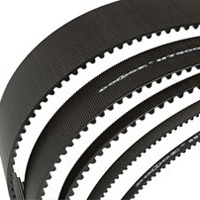Guide to Selecting & Replacing Synchronous Belts
Just as we now consider rotary dial phones archaic, so are many installed synchronous belt drives. That they continue to operate is testimony to their durability—but that should not prevent you from taking advantage of newer synchronous belt drive technology that can improve equipment design, efficiency, and field installations.
 Synchronous belt technology has taken a quantum leap forward since the invention of the timing belt in the 1940s. Synchronous belts now rival roller chain, gears, and other forms of power transmission in almost any application. Research into new compounds, additives,blending processes, jackets, tensile cord materials, and tooth profiles yields further advances every day, resulting in belt drives that pack more power into an ever smaller space.This article will review some basics about synchronous belt drives and highlight some of the technological advancements that might make you rethink that new drive design or replacement drive.
Synchronous belt technology has taken a quantum leap forward since the invention of the timing belt in the 1940s. Synchronous belts now rival roller chain, gears, and other forms of power transmission in almost any application. Research into new compounds, additives,blending processes, jackets, tensile cord materials, and tooth profiles yields further advances every day, resulting in belt drives that pack more power into an ever smaller space.This article will review some basics about synchronous belt drives and highlight some of the technological advancements that might make you rethink that new drive design or replacement drive.
This article was written by Taylor Jung, Product Line Manager, Synchronous Drives, Gates Corporation
You must be logged in to post a comment.